Notes: West Derby station was situated on the Cheshire Lines Railway (CLC) North Liverpool Extension Line that connected the CLC Liverpool and Manchester line at Halewood to Aintree and via a branch to the north Liverpool docks at Huskisson Dock. The CLC was a joint railway with three partners, the Great Northern Railway (GNR), the Manchester Sheffield & Lincolnshire Railway (MS&LR) and the Midland Railway (MR). All had wanted access to Liverpool which by the mid nineteenth century had become a major seaport. The CLC Liverpool and Manchester line which opened on 2 September 1873 had given the three companies access to Liverpool but only to the south docks. To north of the city new docks had been built to accommodate much larger vessels. The London & North Western Railway (LNWR) and the Lancashire & Yorkshire Railway (LYR) had access to the north docks and the CLC partners wanted the same. The most logical way for the CLC to gain such access would have been for them to extend their Liverpool and Manchester line by three miles from its Liverpool terminus. However this would have involved tunnelling under the city centre which would have been prohibitively expensive. The alternative solution was to build a line around the eastern edge of the city using agricultural land that was, by the 1870s, very cheap. The only significant engineering that would be required was at Walton, north of Liverpool. The North Liverpool Extension Line and its branch to Huskisson was authorised on 30 July 1874 and opened from Halewood to Walton-on-the-Hill for passenger services on 1 December 1879.
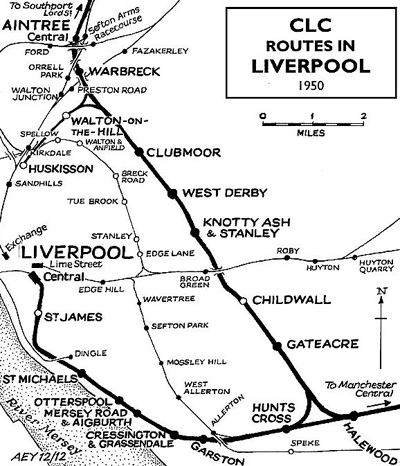 West Derby station opened with the line on 1 December 1879 and was located on the west side of the ancient settlement of West Derby. It was in a cutting on the south side of Mill Lane. The main station building straddled the line at street level. A two-storey house consisted of a pair of adjacent pitched roofs presenting their gables to the road and the railway, flanked to the west by a single-storey range, its pitched roof set at right angles to those of the house; it was set at a slightly higher level than the house presumably reflecting the gradient of the bridge over which the buildings stood. The structure was of brick with sandstone dressings. The flat-headed, mullioned windows with sandstone lintels were a point of interest. Facing the platforms, the placing of the windows on the two-storey structure was curiously asymmetrical. West Derby station opened with the line on 1 December 1879 and was located on the west side of the ancient settlement of West Derby. It was in a cutting on the south side of Mill Lane. The main station building straddled the line at street level. A two-storey house consisted of a pair of adjacent pitched roofs presenting their gables to the road and the railway, flanked to the west by a single-storey range, its pitched roof set at right angles to those of the house; it was set at a slightly higher level than the house presumably reflecting the gradient of the bridge over which the buildings stood. The structure was of brick with sandstone dressings. The flat-headed, mullioned windows with sandstone lintels were a point of interest. Facing the platforms, the placing of the windows on the two-storey structure was curiously asymmetrical.
The bridge that supported the station building was of two arches and constructed from sandstone. Each arch was capable of taking two tracks; only the eastern arch was actually brought into use. The western arch was built with future expansion in mind. The CLC considered that at some point in the future the line, built as a double track railway, would need to be quadrupled. All the road-over-rail bridges and the tunnels along the line were built with quadrupling in mind. It never would expand beyond a double-track line.
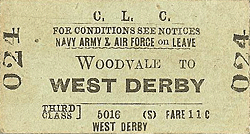 Ramps led down to the platforms on either side of the line. The up (Halewood-bound) platform was provided with a small waiting room of brick with a slate roof. On the down (Aintree-bound) platform there was a timber waiting shelter. The Aintree platform was, of course, adjacent to the track and the ramp leading to it was actually in front of the western side arch of the bridge. The CLC obviously considered that it would be a relatively easy task to alter the platform and ramp should quadrupling be needed. Ramps led down to the platforms on either side of the line. The up (Halewood-bound) platform was provided with a small waiting room of brick with a slate roof. On the down (Aintree-bound) platform there was a timber waiting shelter. The Aintree platform was, of course, adjacent to the track and the ramp leading to it was actually in front of the western side arch of the bridge. The CLC obviously considered that it would be a relatively easy task to alter the platform and ramp should quadrupling be needed.
West Derby had a goods yard which was located on the north side of Mill Lane, east of the line. It had two sidings and a goods shed and was also in a cutting reached by a sloping roadway that connected it to the village.
To the south of the down platform was a signal box that controlled the line through the station and movements into and out of the goods yard. It was a timber box with an 11-lever frame.
At the time of opening West Derby was served by trains running between Walton-on-the-Hill and Liverpool Central. Walton-on-the-Hill was a temporary terminus on the Huskisson branch as tunnels leading down to the docks had not been completed. They were ready by 1 July 1880 when goods services began to run to Huskisson. Passenger services were extended to a new terminus at Huskisson on 2 August 1880 (although race day specials had run from there on 13 July 1880).
For race meetings at Aintree special trains were run for the first time on 13 July 1880 to a CLC station at Aintree provided for just that purpose. West Derby would have been served by some of these trains. The CLC owned its own rolling stock but it did not own any locomotives. All local CLC services were hauled by MS&LR locomotives.
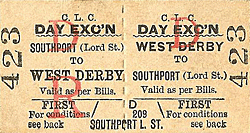 On 11 August 1881 a scheme called the Southport & Cheshire Lines Extension Railway (SCLER) was approved. The CLC backed the scheme which created a line from Aintree to the seaside resort of Southport and made an end-on connection at Aintree to the North Liverpool Extension line. A route to the seaside town with its promise of lucrative traffic would be created that the CLC had agreed to operate (although the SCLER would be a separate company). The SCLER line opened on 1 September 1884. The racecourse station at Aintree opened for public services at the same time. West Derby gained services that ran between Southport and Manchester, Liverpool and Stockport. However the station at Huskisson had proved unremunerative and closed on 13 July 1885. Walton-on-the-Hill became the terminus for local services. On 11 August 1881 a scheme called the Southport & Cheshire Lines Extension Railway (SCLER) was approved. The CLC backed the scheme which created a line from Aintree to the seaside resort of Southport and made an end-on connection at Aintree to the North Liverpool Extension line. A route to the seaside town with its promise of lucrative traffic would be created that the CLC had agreed to operate (although the SCLER would be a separate company). The SCLER line opened on 1 September 1884. The racecourse station at Aintree opened for public services at the same time. West Derby gained services that ran between Southport and Manchester, Liverpool and Stockport. However the station at Huskisson had proved unremunerative and closed on 13 July 1885. Walton-on-the-Hill became the terminus for local services.
The December 1895 timetable showed West Derby as having an intensive service of 19 up and 22 down trains on Monday-to-Friday as seen in the table below. On Sundays there were six trains in each direction.
Up Trains December 1895 |
Destination |
Down Trains December 1895 |
Destination |
8.06am |
Liverpool Central |
7.50am |
Southport Lord Street |
8.40am |
Liverpool Central |
9.39pm |
Southport Lord Street |
8.46am |
Liverpool Central |
10.48pm |
Southport Lord Street |
9.10am |
Liverpool Central |
12.43pm |
Terminating Train from Liverpool Central |
9.36am |
Liverpool Central |
1.41pm |
Southport Lord Street |
11.11am |
Liverpool Central |
1.50pm (Saturdays Only) |
Southport Lord Street |
11.55am |
Manchester Central |
2.18pm |
Southport Lord Street |
1.05pm |
Liverpool Central |
2.47pm (Saturdays Only) |
Southport Lord Street |
1.36pm |
Manchester Central |
3.43pm |
Southport Lord Street |
3.05pm |
Liverpool Central |
3.50pm |
Walton-on-the-Hill |
3.16pm |
Manchester Central |
4.35pm |
Southport Lord Street |
4.38pm |
Liverpool Central |
4.50pm |
Southport Lord Street |
4.54pm (Saturdays Excepted) |
Liverpool Central |
5.27pm (Saturdays Excepted) |
Walton-on-the-Hill |
6.10pm |
Liverpool Central |
5.47pm (Saturdays Only) |
Southport Lord Street |
6.21pm (Saturdays Only) |
Liverpool Central |
6.06pm |
Southport Lord Street |
6.47pm |
Liverpool Central |
6.32pm |
Walton-on-the-Hill |
7.35pm |
Manchester Central |
6.38pm |
Southport Lord Street |
7.53pm (Saturdays Only) |
Liverpool Central |
6.46pm |
Aintree |
7.57pm |
Liverpool Central |
6.51pm (Saturdays Excepted) |
Aintree |
8.46pm |
Liverpool Central |
7.37pm |
Southport Lord Street |
9.30pm (Saturdays Only) |
Manchester Central |
8.24pm |
Walton-on-the-Hill |
10.16pm |
Liverpool Central |
8.46pm |
Southport Lord Street |
|
|
9.40pm |
Southport Lord Street |
|
|
10.57pm (Wednesdays, Thursdays and Fridays Only) |
Southport Lord Street (Via Walton on the Hill) |
|
|
11.24pm |
Walton-on-the-Hill |
|
|
11.24pm (Mondays, Tuesdays & Saturdays Only ) |
Southport Lord Street |
On the 1 August 1897 the MS&LR changed its name to the Great Central Railway (GCR).
In the early years of the twentieth century West Derby station had developed a reputation for its fine floral displays and garden, often winning best kept station awards. The city of Liverpool had expanded rapidly during the nineteenth century, and by the early twentieth its suburbs had reached out as far as West Derby. The Liverpool Corporation Tramways had opened an electric line to West Derby by 1902. It passed along Mill Lane, running directly in front of the station. The trams took a direct route to Liverpool of only a few miles. By train the journey to central Liverpool was nearly ten miles: the trams had an adverse impact on revenue at West Derby station.
A new signal box opened at West Derby on 22 October 1905. It was located 30yd to the south of the original but on the east side of the line. Also built from timber it was a CLC type CL1a with a 16-lever frame.
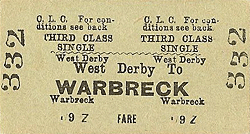 In 1915 the service between Liverpool Central and Walton-on-the-Hill was withdrawn. Despite the loss of these trains West Derby was still well served, the July 1922 timetable showing 12 up and 11 down trains on weekdays with none on Sunday. Most of the up trains ran to Manchester Central with only a few going to Liverpool. Compared to the service offered in 1895 the 1922 timetable showed a significant reduction, and those that did run mostly operated to and from Manchester; tramway competition probably explained this change. In 1915 the service between Liverpool Central and Walton-on-the-Hill was withdrawn. Despite the loss of these trains West Derby was still well served, the July 1922 timetable showing 12 up and 11 down trains on weekdays with none on Sunday. Most of the up trains ran to Manchester Central with only a few going to Liverpool. Compared to the service offered in 1895 the 1922 timetable showed a significant reduction, and those that did run mostly operated to and from Manchester; tramway competition probably explained this change.
At the grouping of 1923 the CLC remained independent but its parent companies changed. The GCR and the GNR became constituents of the London & North Eastern Railway (LNER) whilst the MR became part of the London Midland & Scottish Railway (LMS). The LNER was given two-thirds of the CLC shares and the LMS one-third. Motive power for CLC services was provided by the LNER.
The summer timetable for 1932 showed West Derby as having ten up and ten down trains. There were two in each direction on Sundays. Ten trains ran to Southport Lord Street, eight to Manchester Central, and one each to Warrington Central and Liverpool Central.
During the Second World War passenger services on the line were cut back. The route through West Derby was of national strategic importance as it provided a link between Britain’s western gateway (Liverpool Docks) and the rest of the country. It was extremely busy, freight trains running day and night almost in convoy. The only exception with regard to passenger services was between 24 December 1940 and 5 July 1941. Heavy bombing had damaged the extremely busy commuter line between Southport Chapel Street and Liverpool Exchange at the Liverpool end of the line. To enable Southport commuters to travel into the city and return home each day extra trains were provided between Liverpool Central and Southport Lord Street. The journey would have taken much longer, but it allowed the city to continue functioning. These trains would not have called at West Derby.
On 1 January 1948 the CLC became part of British Railways London Midland Region. The summer timetable for 1948 showed West Derby as having ten up trains and eight down Monday-to-Friday as indicated in the table below. There were eleven up and eight down on Saturdays and four in each direction on Sundays.
Up Trains Summer 1948 |
Destination |
Down Trains Summer 1948 |
Destination |
6.50am |
Manchester Central |
7.39am |
Southport Lord Street |
7.29am |
Hunts Cross |
11.16am |
Southport Lord Street |
8.05am |
Manchester Central |
12.59pm (Saturdays Only) |
Southport Lord Street |
8.23am |
Warrington Central |
1.07pm (Saturdays Excepted) |
Southport Lord Street |
8.51am |
Liverpool Central |
1.20pm (Saturdays Only) |
Southport Lord Street |
11.24am |
Hunts Cross |
2.19pm (Saturdays Only) |
Southport Lord Street |
1.11pm |
Warrington Central |
4.11pm |
Southport Lord Street |
6.04pm (Saturdays Excepted) |
Liverpool Central |
5.54pm (Saturdays Excepted) |
Southport Lord Street |
6.14pm (Saturdays Only) |
Liverpool Central |
6.13pm (Saturdays Excepted) |
Southport Lord Street |
7.58pm |
Garston |
6.21pm (Saturdays Only) |
Southport Lord Street |
8.55pm (Saturdays Only) |
Warrington Central |
6.37pm (Saturdays Excepted) |
Aintree |
9.00pm (Saturdays Excepted) |
Hunts Cross |
7.06pm |
Southport Lord Street |
9.41pm (Saturdays Only) |
Liverpool Central |
|
|
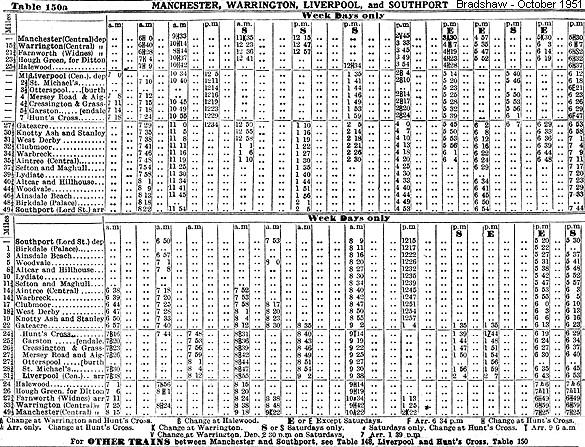 |
The new nationalised railway saw no need for the former SCLER as it could run trains from the North Liverpool Extension line to Southport Chapel Street via a connection with the former LYR network at Aintree. The SCLER passed through sparsely inhabited country and was un-remunerative. Passenger services between Aintree (which British Railways renamed Aintree Central on 1 July 1950) and Southport Lord Street were withdrawn from 7 January 1952.
West Derby was left with a scheduled train service operating, in the main, between Aintree Central and Manchester Central. The station was also served by summer excursions to Southport Chapel Street. For local journeys West Derby station was of limited value: by summer 1957 its service had been reduced to only three up and three down trains on Monday-to-Saturday as shown in the table below.
Up Trains Summer 1957 |
Destination |
Down Trains Summer 1957 |
Destination |
6.47am |
Manchester Central |
12.56pm (Saturdays Only) |
Aintree Central |
7.49am |
Manchester Central |
1.12pm (Saturdays Only) |
Aintree Central |
8.18am |
Warrington Central |
2.13pm (Saturdays Only) |
Aintree Central |
|
|
5.59pm (Saturdays Excepted) |
Aintree Central |
|
|
6.12pm (Saturdays Excepted) |
Aintree Central |
|
|
6.33pm (Saturdays Excepted) |
Aintree Central |
With the last up departure being at 8.18am and the first Monday-to-Friday down departure being at 5.59pm the service was next to useless for anything other than work journeys.
Despite the reduction in services on the line, British Railways carried out some modest updating of station signage, installing maroon totems at West Derby as well as at Knotty Ash, Clubmoor and Warbreck.
It came as little surprise when British Railways proposed the withdrawal of the service in 1960. The last regular trains to serve West Derby ran on Saturday 5 November 1960, and the station closed to passengers on Monday 7 December 1960.
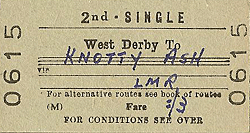 The station saw occasional use by excursions during the 1960s. The line itself continued to be used by Grand National race day trains until 1963. It then went into decline. West Derby station closed completely on 1 June 1964. The signal box closed on 8 November 1964. On 22 September 1968 the line between Fazakerley South Junction and Aintree Central was taken out of use leaving only the goods services to and from Huskisson. On 30 November 1969 the line through West Derby between Walton-on-the-Hill and Knotty Ash was singled. By 1973 there was only one daily freight working from Edge Hill to Huskisson and return: it ceased in August 1975. The station saw occasional use by excursions during the 1960s. The line itself continued to be used by Grand National race day trains until 1963. It then went into decline. West Derby station closed completely on 1 June 1964. The signal box closed on 8 November 1964. On 22 September 1968 the line between Fazakerley South Junction and Aintree Central was taken out of use leaving only the goods services to and from Huskisson. On 30 November 1969 the line through West Derby between Walton-on-the-Hill and Knotty Ash was singled. By 1973 there was only one daily freight working from Edge Hill to Huskisson and return: it ceased in August 1975.
By this time the Merseyside Passenger Transport Authority had come into being. Based on plans drawn up by the local authorities in the 1960s the line through West Derby took on a new significance. It was proposed that an outer belt line be created along the former CLC North Liverpool Line and it was actually authorised by the Act of 1971. Although many of the lines proposed in the Act were created, the economic downturn of the late 1970s and early 1980s ended hopes for the belt line scheme. British Rail lifted the line between Huskisson and Hunts Cross in the early months of 1979.
In the late 1980s a footpath and cycleway called the ‘Liverpool Loopline Path’, part of the Trans-Pennine Trail, was created through the site of West Derby station. The station survived closure and was extant in December 2012. The building was in use as a private dwelling and as by 'The Gas Station' a gas showroom. A housing estate was built on the goods yard in the 1990s.
Tickets by Michael Stewart, and Bradshaw by Nick Catford.
With special thanks to Les Brunskill of The Gas Station.
Sources:
- The Cheshire Lines Committee, by P Bolger, Heyday Publishing Company 1984.
- Bradshaw Timetable December 1895.
- Bradshaw Timetable July 1922.
- LMS Timetable Summer 1932.
- BR (LMR) Summer Timetable 1948.
- BR (LMR) Summer Timetable 1957.
- Cheshire Lines Committee Signal Box Register, M J Addison & J D Dixon 1996.
- Roads, Rails & Ferries of Liverpool, J Joyce, Ian Allan 1983.
To see the other
stations on the CLC North Liverpool Extension Line click on the
station name: Aintree Central, Warbreck, Clubmoor, Knotty Ash, Childwall & Gateacre
See also Huskisson branch stations
Walton on the
Hill & Huskisson
For stations on
Southport & Cheshire Lines Extension Railway click on the
station name: Southport
Lord Street, Birkdale
Palace, Ainsdale Beach, Woodvale, Mossbridge, Altcar & Hillhouse, Lydiate & Sefton and Maghull
|

derby_old2.jpg)
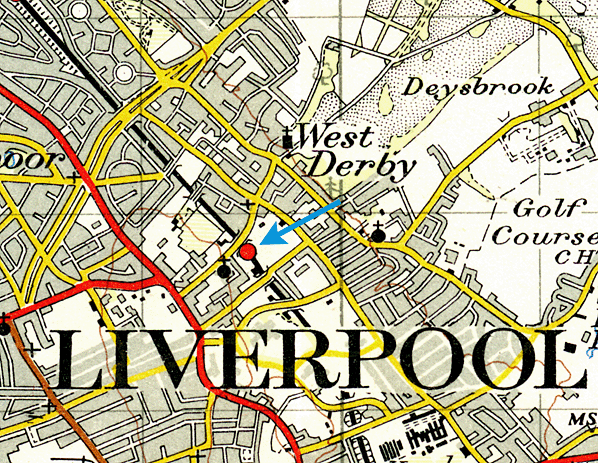
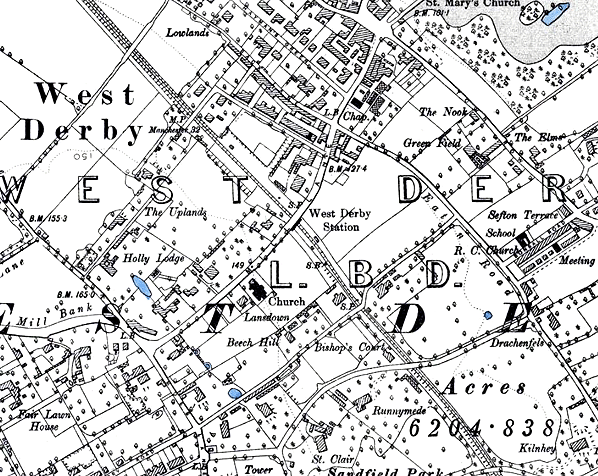
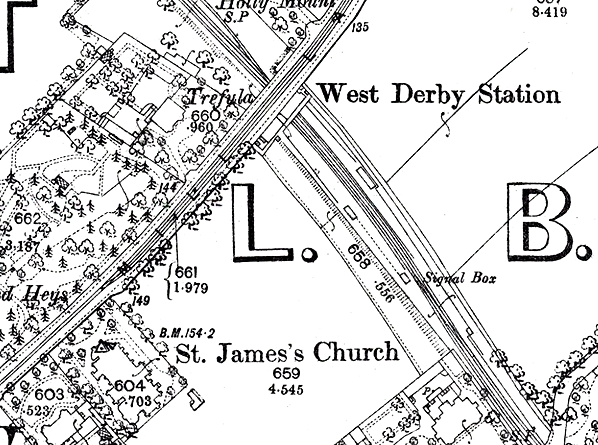
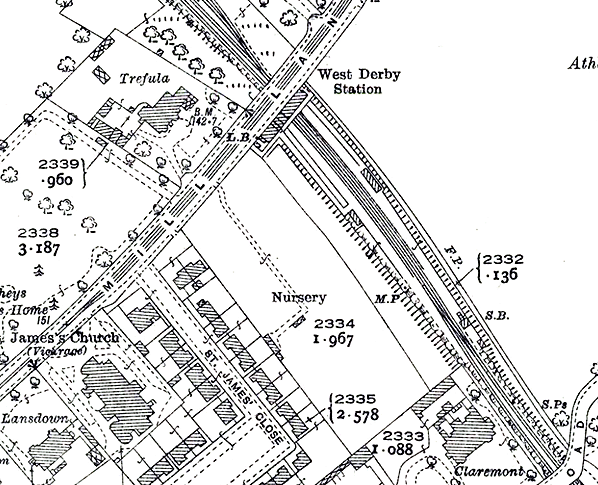
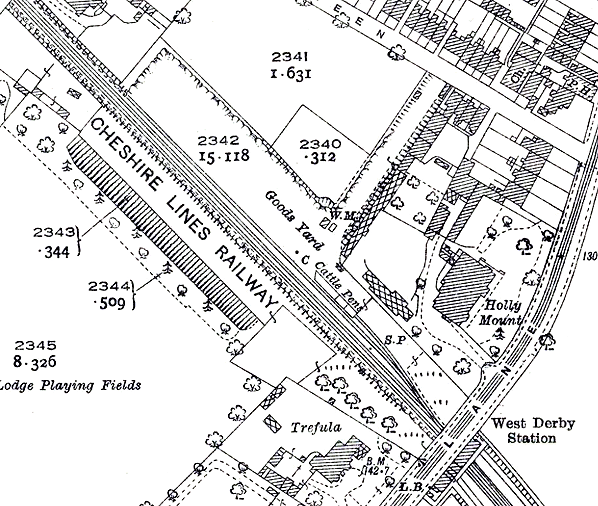
derby_old1.jpg)
derby_old.jpg)
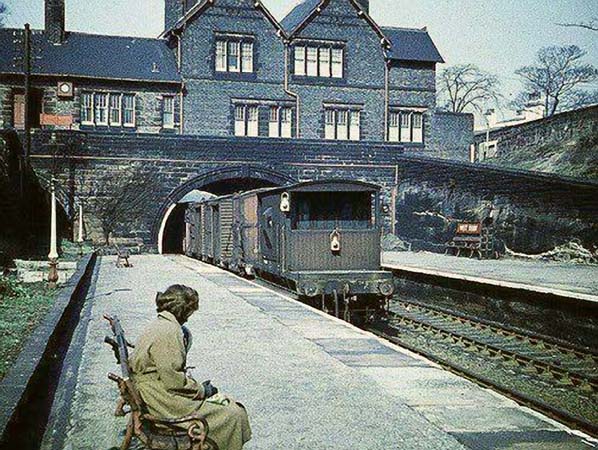
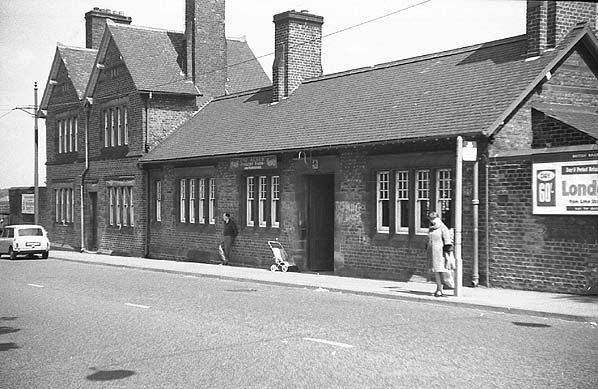
derby10.jpg)
.jpg)
 West Derby station opened with the line on 1 December 1879 and was located on the west side of the ancient settlement of West Derby. It was in a cutting on the south side of Mill Lane. The main station building straddled the line at street level. A two-storey house consisted of a pair of adjacent pitched roofs presenting their gables to the road and the railway, flanked to the west by a single-storey range, its pitched roof set at right angles to those of the house; it was set at a slightly higher level than the house presumably reflecting the gradient of the bridge over which the buildings stood. The structure was of brick with sandstone dressings. The flat-headed, mullioned windows with sandstone lintels were a point of interest. Facing the platforms, the placing of the windows on the two-storey structure was curiously asymmetrical.
West Derby station opened with the line on 1 December 1879 and was located on the west side of the ancient settlement of West Derby. It was in a cutting on the south side of Mill Lane. The main station building straddled the line at street level. A two-storey house consisted of a pair of adjacent pitched roofs presenting their gables to the road and the railway, flanked to the west by a single-storey range, its pitched roof set at right angles to those of the house; it was set at a slightly higher level than the house presumably reflecting the gradient of the bridge over which the buildings stood. The structure was of brick with sandstone dressings. The flat-headed, mullioned windows with sandstone lintels were a point of interest. Facing the platforms, the placing of the windows on the two-storey structure was curiously asymmetrical. Ramps led down to the platforms on either side of the line. The up (Halewood-bound) platform was provided with a small waiting room of brick with a slate roof. On the down (Aintree-bound) platform there was a timber waiting shelter. The Aintree platform was, of course, adjacent to the track and the ramp leading to it was actually in front of the western side arch of the bridge. The CLC obviously considered that it would be a relatively easy task to alter the platform and ramp should quadrupling be needed.
Ramps led down to the platforms on either side of the line. The up (Halewood-bound) platform was provided with a small waiting room of brick with a slate roof. On the down (Aintree-bound) platform there was a timber waiting shelter. The Aintree platform was, of course, adjacent to the track and the ramp leading to it was actually in front of the western side arch of the bridge. The CLC obviously considered that it would be a relatively easy task to alter the platform and ramp should quadrupling be needed.  On 11 August 1881 a scheme called the Southport & Cheshire Lines Extension Railway (SCLER) was approved. The CLC backed the scheme which created a line from Aintree to the seaside resort of Southport and made an end-on connection at Aintree to the North Liverpool Extension line. A route to the seaside town with its promise of lucrative traffic would be created that the CLC had agreed to operate (although the SCLER would be a separate company). The SCLER line opened on 1 September 1884. The racecourse station at Aintree opened for public services at the same time. West Derby gained services that ran between Southport and Manchester, Liverpool and Stockport. However the station at Huskisson had proved unremunerative and closed on 13 July 1885. Walton-on-the-Hill became the terminus for local services.
On 11 August 1881 a scheme called the Southport & Cheshire Lines Extension Railway (SCLER) was approved. The CLC backed the scheme which created a line from Aintree to the seaside resort of Southport and made an end-on connection at Aintree to the North Liverpool Extension line. A route to the seaside town with its promise of lucrative traffic would be created that the CLC had agreed to operate (although the SCLER would be a separate company). The SCLER line opened on 1 September 1884. The racecourse station at Aintree opened for public services at the same time. West Derby gained services that ran between Southport and Manchester, Liverpool and Stockport. However the station at Huskisson had proved unremunerative and closed on 13 July 1885. Walton-on-the-Hill became the terminus for local services.
 In 1915 the service between Liverpool Central and Walton-on-the-Hill was withdrawn. Despite the loss of these trains West Derby was still well served, the July 1922 timetable showing 12 up and 11 down trains on weekdays with none on Sunday. Most of the up trains ran to Manchester Central with only a few going to Liverpool. Compared to the service offered in 1895 the 1922 timetable showed a significant reduction, and those that did run mostly operated to and from Manchester; tramway competition probably explained this change.
In 1915 the service between Liverpool Central and Walton-on-the-Hill was withdrawn. Despite the loss of these trains West Derby was still well served, the July 1922 timetable showing 12 up and 11 down trains on weekdays with none on Sunday. Most of the up trains ran to Manchester Central with only a few going to Liverpool. Compared to the service offered in 1895 the 1922 timetable showed a significant reduction, and those that did run mostly operated to and from Manchester; tramway competition probably explained this change. 
 The station saw occasional use by excursions during the 1960s. The line itself continued to be used by Grand National race day trains until 1963. It then went into decline. West Derby station closed completely on 1 June 1964. The signal box closed on 8 November 1964. On 22 September 1968 the line between Fazakerley South Junction and Aintree Central was taken out of use leaving only the goods services to and from Huskisson. On 30 November 1969 the line through West Derby between Walton-on-the-Hill and Knotty Ash was singled. By 1973 there was only one daily freight working from Edge Hill to Huskisson and return: it ceased in August 1975.
The station saw occasional use by excursions during the 1960s. The line itself continued to be used by Grand National race day trains until 1963. It then went into decline. West Derby station closed completely on 1 June 1964. The signal box closed on 8 November 1964. On 22 September 1968 the line between Fazakerley South Junction and Aintree Central was taken out of use leaving only the goods services to and from Huskisson. On 30 November 1969 the line through West Derby between Walton-on-the-Hill and Knotty Ash was singled. By 1973 there was only one daily freight working from Edge Hill to Huskisson and return: it ceased in August 1975.

 Home Page
Home Page